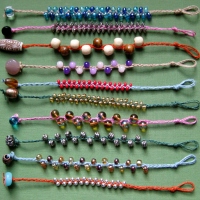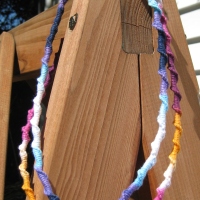Let’s say you’ve mastered the basics of knitting a scarf on the Knifty Knitter long loom and want to branch out to more advanced projects. I recommend trying out some specialty yarns. A little sparkle or texture can add pizzazz to your knitting projects.
Specialty yarns, like Bernat Boa, can be tricky to use with Knifty Knitter looms. Although they are technically considered bulky, these types of yarn don’t have enough weight to them to use alone on these looms. I found this out the hard way when I made a beautiful, feathery, pink scarf for my boyfriend’s niece. The stitches loosened almost immediately after she started trying to wear it.
I don’t like to make the same mistake twice, so I decided to bulk up some Bernat Boa with the addition of two medium weight yarns – Caron Simply Soft and Red Heart Soft – for my next scarf. You might wonder why I chose two different brands of medium weight yarn. To be completely honest, the decision was color-related. I couldn’t find two coordinating yarns of the same brand for my Bernat Boa in Bright Glitter the day I went shopping. Although you could certainly use two colors of either Caron Simply Soft or Red Heart Soft, you get an added textural element when you mix and match like I did.
Supplies:
- Bernat Boa in Bright Glitter (1 ball)
- Caron Simply Soft in Blue Mint (1 ball)
- Red Heart Soft in Grape (1 ball)
- Knifty Knitter Long Loom
- Knifty Knitter Knitting Tool
- Scissors
For this scarf, you can follow right along with the instructions provided with your Knifty Knitter long loom. Think of your yarns not as three different ones but instead one three-stranded yarn. You’re going to wrap and knit the pegs with all three yarns at the same time.
To get started, tie a slip knot at the end your yarn and place it on the peg at the end of the loom. Cast onto 7 pegs on each side of the loom. Once you reach the last peg, you’ll begin wrapping in the opposite direction. Be sure to reference your instruction pamphlet if you need a refresher. I have a little tip for remembering which way you should be wrapping your pegs. When you’re working towards the right end of your loom, you should be wrapping your yarn around the right side of the pegs. Not surprisingly, you should be wrapping your yarn around the left side of the pegs when you’re working towards the left end of the loom.
Now that you have two loops on each peg, you can begin knitting. Grab the bottom loop with your knitting tool, making sure to get all three yarns. Lift it up and over the peg. Do this with all the pegs, zig zagging from front to back pegs sequentially. Again get out your instructions if you need additional help.
Once you reach the last peg, start wrapping the pegs again in the opposite direction. Then knit this row by once again lifting the bottom loop up and over the pegs. You’ll continue doing this until your scarf reaches your desired length. I personally like mine to be between 5 and 6 ft. long.
With only one loop left on each peg, you can cast off of the loom to finish your scarf. I don’t always find it necessary to use a crochet hook to do this like the Knifty Knitter instructions recommend, but this is a time when the crochet hook can be handy since you’re dealing with essentially 6 different yarns on one hook. Make sure you start this process with a good deal of patience. You don’t want to get to the end of all your hard work and ruin the whole project because you got frustrated or rushed. Maybe it’s just me that’s prone to do either of those!
Starting at the end of your loom farthest from your working yarn, lift the loop off the peg and onto your crochet hook or knitting tool. Do the same with yarn from the peg directly across from it. With two loops on your hook, pull the second one through the first and off the hook or knitting tool. Here’s where the patience comes into play because you’re working with 3 different yarns. Just take your time, and you’ll eventually make it the whole way down the loom. When you get to the last loop, snip your yarn and pass the tail through the loop. I like to cut off the excess. You can also weave the ends into your scarf like the instructions suggest. Don’t forget to do the same with the beginning of your scarf.
After I’m done knitting with Bernat Boa, I like to take the knitting tool and fluff out the yarn a little bit. Some one of the feathery, glitteriness gets lost in the stitches while you work. I hope this scarf inspires you to experiment with other specialty yarns on your looms. Happy loom knitting!




